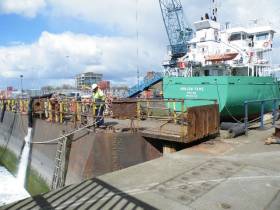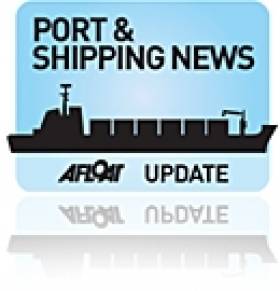Displaying items by tag: Dublin Graving Docks Ltd
Final Vessel to Dublin Dry-Dock is Aptly Irish-Flagged Cargoship
#FinalShip – The last ever vessel to use Dublin's dry-dock, cargoship Arklow Fame departed on Wednesday from the unique facility in the capital that officially closes today, writes Jehan Ashmore.
The shiprepairer, maintenance and engineering facility has since 2002 been run by Dublin Graving Docks Ltd under license of the Dublin Port Company. The port company has other plans for the site as part of the €277m ABR project, see report.
Today’s closure marks the end of a chapter in Irish maritime industry that is consigned to historical heritage as well as the loss of 26 jobs staff. The small yet skilled workforce have taken on tasks involving numerous vessels among them containerships, coasters, ro-ro freight ferries, supertrawlers, tugs and timber tallships.
It was fitting that the final vessel to use graving dock no.2 was the Irish flagged Arklow Shipping cargoship and given the Co. Wicklow based company were the firm's largest client.
The 90m Arklow Fame (4,950dwt) is one of the smaller cargoships in the ASL fleet to use the dry-dock as dry bulk-carriers such as the 136m Arklow Marsh (14,490dwt) have occupied the 220m long dockyard completed in 1957. In recent years the ‘M’ class have undergone conversion work at the country's largest dry dock in the capital to increase deadweight tonnage.
Asides routine work carried out on Arklow Fame, the leadship of 10 Spanish built ‘F’ class vessels built a decade ago, also saw work to install a new rudder stock. This involved a manufacturer in Europe to make the replacement part which was transported by truck to be installed at the Dublin facility.
The graving dock could take vessels up to 6.5m draft and had a 24.5m wide entrance accessed by a gate (caisson) see above photo. The watertight retaining structure would be floated in and out of position between pumping in or out water of the dry dock. It should be noted even when a ship was not in dry-dock, work took place at the yard's marine workshop and also off site where required.
Now that the dry dock is closed, ASL will be forced to go elsewhere, noting that Cork Dockyard has a graving dock, measuring 165.5m long and has a narrower entrance of 21.3m. Technically speaking, Arklow Fame with a beam of 14.5m could be accommodated at the country's now largest dry-dock.
So it remains the issues of cost, expertise and strategic location that will determine where shipowners take their business to a graving dock, be it at home or overseas.
In fact during Cork-Swansea Ferries operation and that of the main ferry that ran throughout those years was carried out by the Superferry, however her beam was too wide to use the Cork dry-dock. Instead, the Japanese ferry of more than 14,000 gross tonnes docked at the Dublin facility.
The frequency of ferries using Dublin dry dock however notably declined from around the mid-1990's as the size of newbuilds introduced on the Irish Sea have dramatically increased in tonnage.
This trend in larger ferries undergoing refit overhauls and repairs are mostly carried out in Belfast (Harland & Wolff), Birkenhead (Cammel Laird) and Falmouth (A&P Falmouth).
Irish-Dutch Cargoship Dry Docks In Dublin
#DublinDryDocks - Dublin Graving Docks Ltd which as previously reported on Afloat.ie faces closure by Dublin Port Co. over plans to redevelop Alexandra Basin that incorporates the site of the 200m long graving dock is currently occupied by a pair of vessels, writes Jehan Ashmore.
The dry docked vessels at the ship-repairer and conversion business are the Dutch built Arklow Raider (2002/2,999grt) one of Arklow Shipping's general cargoships flagged in the Netherlands and the museum tallship Jeanie Johnston.
Up to 26 people are employed at the facility which has seen an increase in clients compared to last year. The dockyard primarily caters for trawlers and larger dry-cargo vessels than that of Arklow Raider, among them the 8,900 tonnes 'W' class and 9,700 tonnes 'M' class series from the Irish flagged fleet of Arklow Shipping Ltd.
One of the 'M' class vessels, Arklow Mill which was featured on Afloat.ie during a call to the Shannon at Aughinish Alumina plant, had work carried out by Dublin Graving Dock in 2013. This was to increase the deadweight tonnage (dwt) up to 14,990 tonnes, making her one of the largest in the fleet until the more recent introduction of 'S' class sisters each of 34,905dwt.
The Dutch division of ASL operate a smaller fleet of vessels registered in Rotterdam from where Arklow Shipping Netherlands are based.
When either of the W and M class vessels are booked into the dry-dock due to their overall dimensions they take up the entire graving dock. The graving dock can accommodate ships drawing a maximum draft of 6.5m and having a beam of up to 24.5m.
In the current circumstance of two vessels within Graving Dock No. 2, a dockgate (caisson) divides the ships apart into separate chambers. This will allow the Dutch built Arklow Raider to vacate first as her work is scheduled to be completed prior to that of Jeanie Johnston.
The chamber where Arklow Raider occcupies will be flooded and without interrupting the Jeanie Johnston. Work on the barque is not expected to be completed until later this month. Her opening date as a museum ship has been advertised as 1 November.






























































